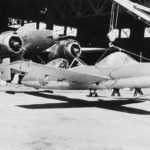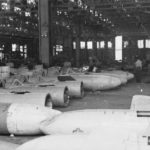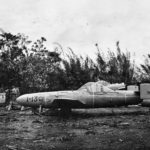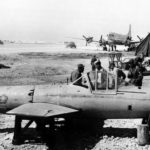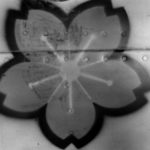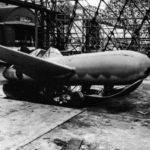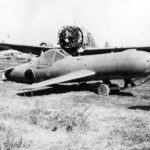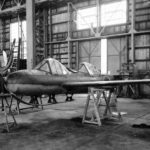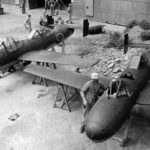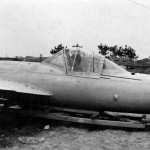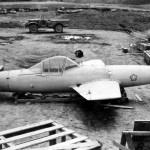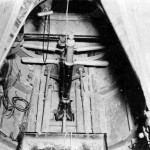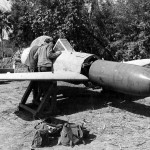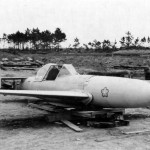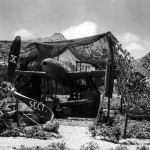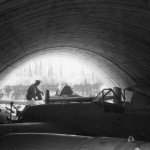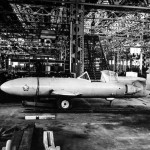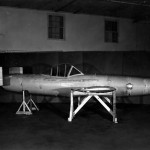Ohka Model 43 K-1 Kai Wakazakura October 1945
MXY-7 Ohka “Baka” assembly line, 1945
Ohka bomb in hardened bunker Japan September 1945
Captured MXY-7 Ohka 1-13 Okinawa, 1945
Captured Yokosuka MXY-7 “1-18” suicide plane at Yontan
Ohka cherry blossom Insignia Okinawa 1945
Abandoned MXY-7 Ohka 1-18 on Okinawa
Trainer MXY-7 K-1 on wheeled sled 1945
MXY-7 Ohka rocket engine
MXY-7 Ohka 1-18 under guard on Okinawa, color photo
Trainer Ohka K-1 1945
Yokosuka MXY-7 K-1 Ohka 1945
Two-seat Ohka Model 43 K-1 Kai Wakazakura
Ohka Model 43 K-1 Kai Wakazakura 2
MXY-7 Ohka 2
Yokosuka MXY7 Ohka cockpit left side Okinawa
Yokosuka MXY7 Ohka left side Okinawa
Yokosuka MXY-7 Ohka cockpit interior 2
Yokosuka MXY7 Ohka right side Okinawa
Rear View Of The Ohka Plane Showing Cone Where 3 Rockets Are Placed
Kamikaze aircraft Yokosuka MXY7 Ohka Okinawa
The Yokosuka MXY-7-1 Ohka cockpit interior
Yokosuka MXY7 Ohka nose Okinawa
Yokosuka MXY-7 Ohka I-18 Okinawa 3
Yokosuka MXY7 Ohka rear view
Kamikaze aircraft Yokosuka MXY-7 Ohka I-18 Okinawa
Yokosuka MXY-7 Ohka I-18 Okinawa 4
Yokosuka MXY7 Ohka Kadena Airfield Okinawa
Kamikaze attack plane Yokosuka MXY7 Ohka Okinawa
Yokosuka MXY-7 Ohka I-18 Okinawa 2
kamikaze attack plane MXY7 Ohka number 1-13
kamikaze attack plane Yokosuka MXY7 Ohka Baka number 07
Yokosuka MXY1 ohka baka kamikaze guided bomb Atsugi 1945
Yokosuka MXY7 Ohka rocket bombs found in underground hangar Atsugi 1945
Cockpit of Yokosuka MXY7 Ohka baka rocket bomb Atsugi 1945
Yokosuka Ohka Baka found in Hangar Japan September 1945
Photographed by Cpt Perry Jacob Weil
Yokosuka MXY7 ohka baka rocket bomb Atsugi 1945
captured Yokosuka MXY7 Ohka Suicide Plane
Yokosuka MXY7 Ohka baka rocket exhaust ports atsugi 1945
Yokosuka MXY7 Ohka Baka Bomb Rear View, Okinawa 1945
Yokosuka MXY7 Ohka Suicide Plane number 1-18
Yokosuka Ohka Baka found in Hangar Japan September 1945 right
kamikaze plane Yokosuka MXY7 Ohka 1-18
Yokosuka MXY-7 Ohka (kamikaze attack plane)
The prototype Yokosuka MXY-7 Ohka was flown in the early autumn of 1944, a training glider version following shortly afterwards. In September 1944 production commenced of the Ohka Model 11, the only operational version, 755 of which were completed up to March 1945 before being superseded on the assembly lines by later models. These included the slightly smaller Ohka 22, fifty of which were built with a 110 hp engine driving a Campini style compressor to give 1,95 kN propulsive thrust: the Ohka 33 (intended for carriage by the G8N1 Renzan bomber and powered by a 4,6 kN gas turbine) was abandoned in favour of the similarly powered Ohka 43, designed for launching from catapults, which was to have entered production in October 1945. The Ohka 11 was carried by a mother plane, usually a Mitsubishi G4M2e Betty, bneath whose open bomb bay it was shackled during flight. The launch generally took place at about 8000 m and a speed of 320 km/h, from which the Ohka would glide at some 370 km/h for about 80 km towards its target before cutting in its rocket motors for the final 50-degree death dive.
Specifications (Ohka Model 11):
crew: 1
powerplant: 3 x Type 4 Mark I Model 20 solid fuel rockels, each developing 2,67kN of thrust, for a total of 8,01kN
span: 5.12m
length: 6.06m
height: 1.15m
wing area: 5.99 m2
wing loading: 356.90kg/m2
power loading: 2.67kg/hp
empty weight: 440kg
loaded weight: 2140.5kg
useful load: 650kg
max speed: 649km/h at 3505m
dive speed: 927-1040 km/h
cruise speed: 462km/h at 3500m
max range: 37km
ceiling: 8250m
armament: 1200kg explosive warhead
Bibliography:
- Rene J. Francillon – Mitsubishi G4M Betty & Ohka Bomb – Aircraft Profile Number 210
- Edvard T. Malaney – Kamikaze: The Oka Suicide Flying Bomb; Bachem Ba 349A “Natter”; and FZG-76 “Reichenberg” – Aero Series 7
- Steven J. Zaloga – Kamikaze: Japanese Special Attack Weapons 1944–45 (Osprey New Vanguard 180)
- Robin L. Rielly – Kamikaze Attacks of World War II: A Complete History of Japanese Suicide Strikes on American Ships, by Aircraft and Other Means
- Albert Axell, Hideaki Kase – Kamikaze: Japan’s Suicide Gods
- Peter C. Smith – Kamikaze – To Die for the Emperor
- G. Sheftall – Blossoms in the Wind: Human Legacies of the Kamikaze
- Yasuo Kuwahara, Gordon T. Allred – Kamikaze: A Japanese Pilot’s Own Spectacular Story of the Famous Suicide Squadrons
- American Aces against the Kamikaze – Osprey Aircraft of the Aces 109
- Rikihei Inoguchi, Tadashi Nakajima, Roger Pineau – The Divine Wind: Japan’s Kamikaze Force in World War II
- Rene J. Francillon – Japanese Aircraft of the Pacific War
